Management Accounting Report: Oshodi Plc's Financial Performance
VerifiedAdded on 2021/02/22
|15
|4424
|59
Report
AI Summary
This report provides a comprehensive analysis of management accounting practices at Oshodi Plc, a UK-based fruit juice manufacturer. It begins with an introduction to management accounting and its essential requirements, focusing on the different accounting systems like cost accounting, inventory management, and price optimization. The report then explores the benefits of these systems and their integration within organizational processes, emphasizing the importance of various management accounting reports such as performance reports, inventory management reports, and accounts receivable reports. Furthermore, the report delves into the application of cost analysis techniques to prepare income statements using both marginal and absorption costing methods, including detailed calculations and comparisons. The analysis includes income statements for November and December, showcasing the impact of different costing methods on profitability. The report concludes by summarizing the key findings and their implications for effective decision-making within Oshodi Plc.
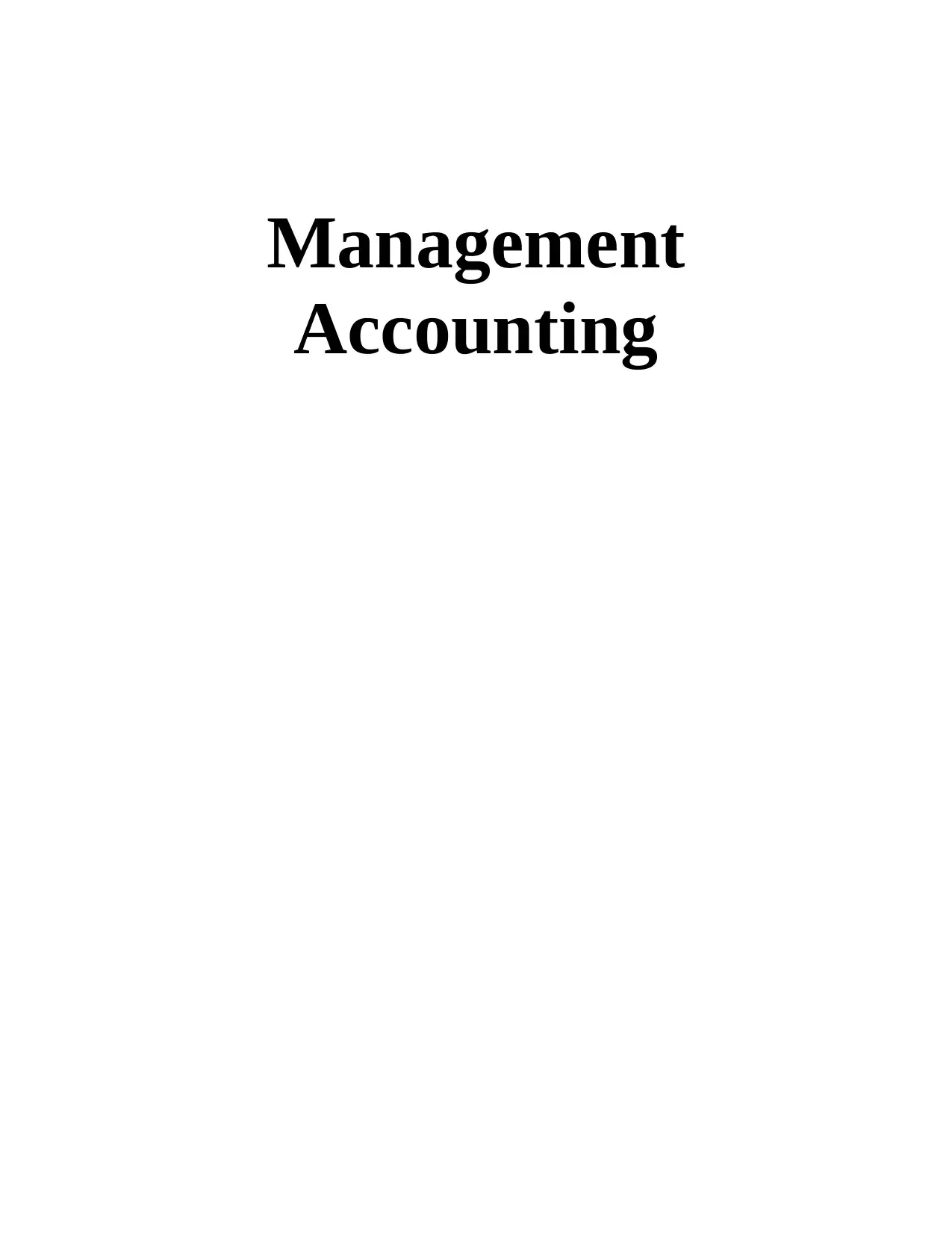
Management
Accounting
Accounting
Paraphrase This Document
Need a fresh take? Get an instant paraphrase of this document with our AI Paraphraser
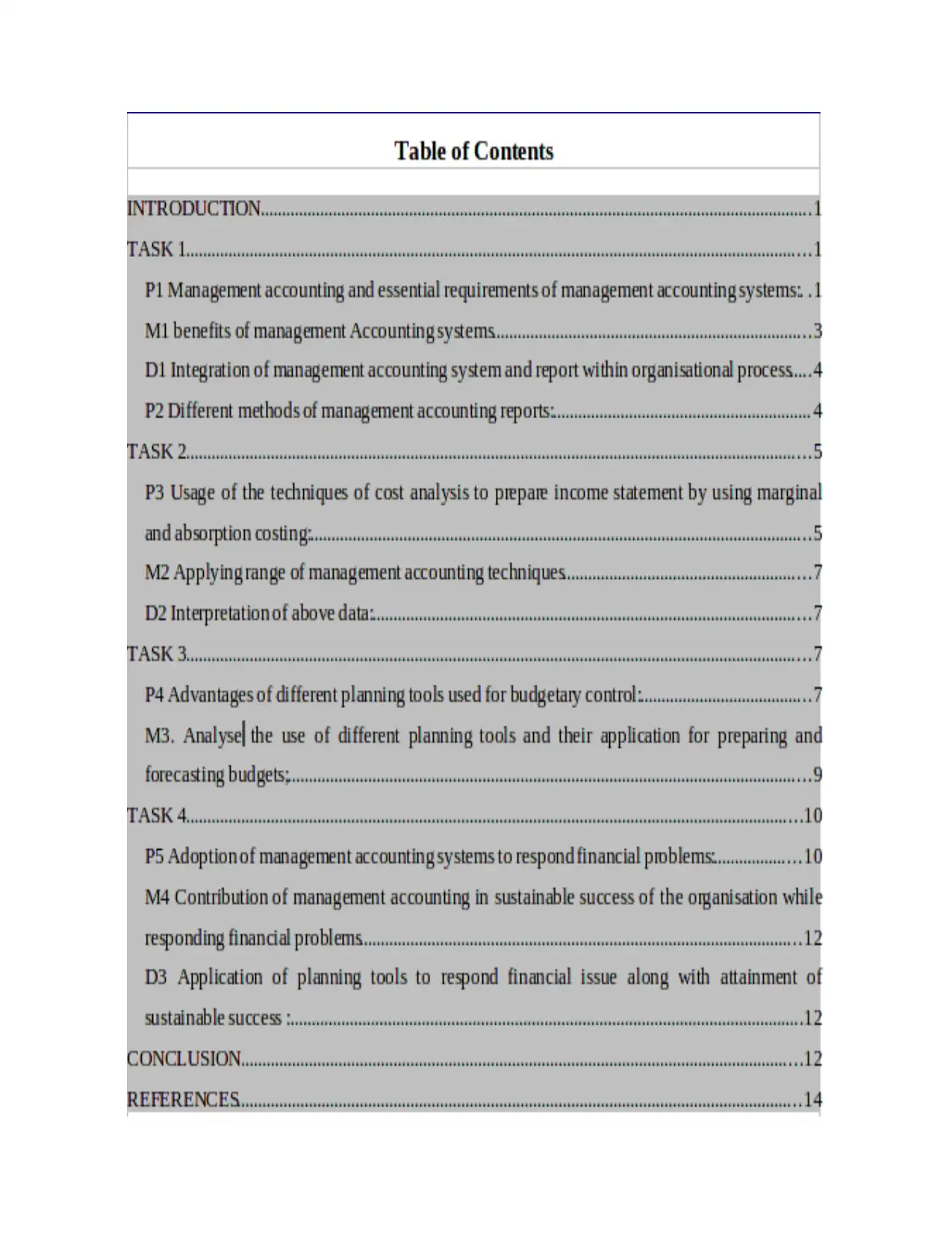
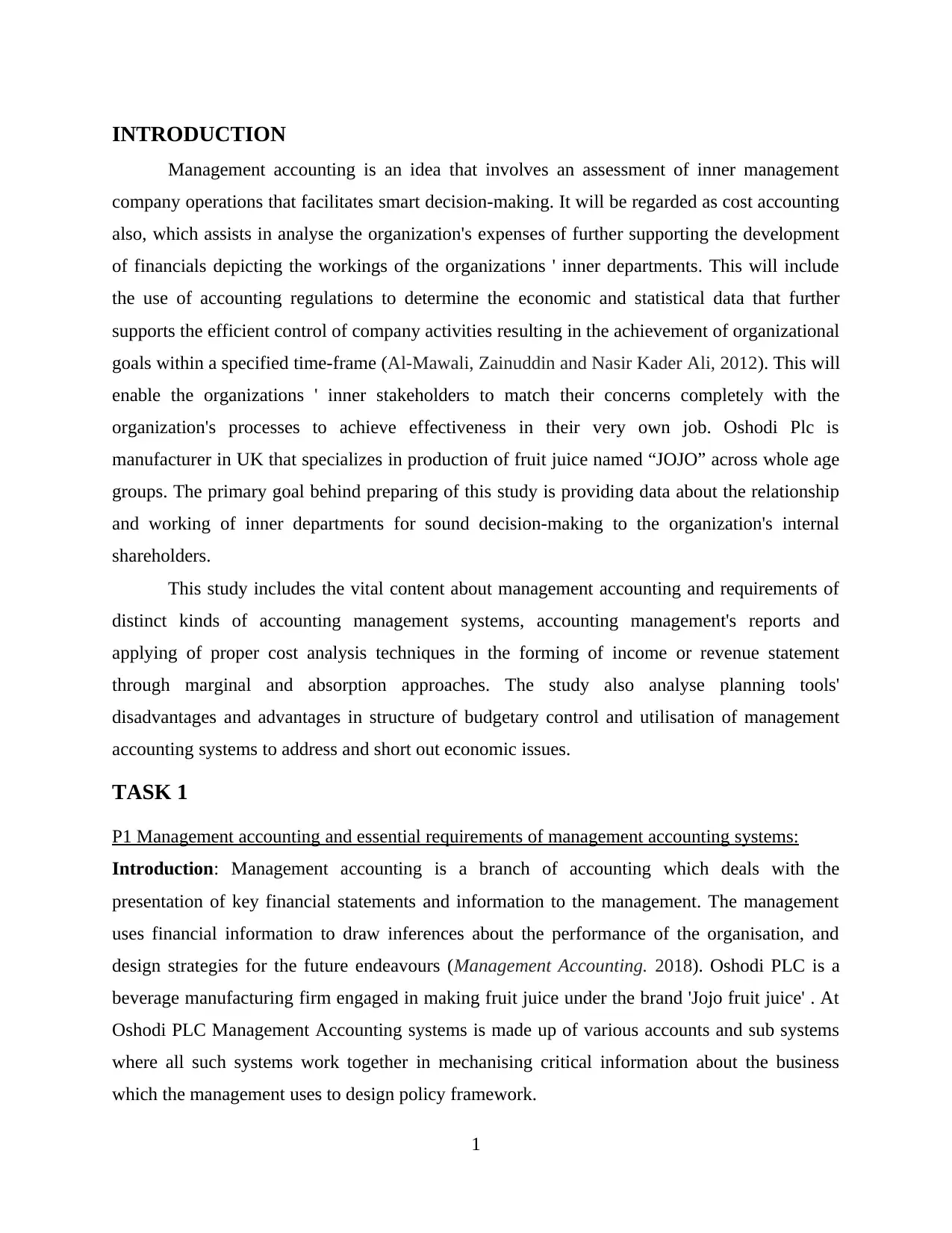
INTRODUCTION
Management accounting is an idea that involves an assessment of inner management
company operations that facilitates smart decision-making. It will be regarded as cost accounting
also, which assists in analyse the organization's expenses of further supporting the development
of financials depicting the workings of the organizations ' inner departments. This will include
the use of accounting regulations to determine the economic and statistical data that further
supports the efficient control of company activities resulting in the achievement of organizational
goals within a specified time-frame (Al-Mawali, Zainuddin and Nasir Kader Ali, 2012). This will
enable the organizations ' inner stakeholders to match their concerns completely with the
organization's processes to achieve effectiveness in their very own job. Oshodi Plc is
manufacturer in UK that specializes in production of fruit juice named “JOJO” across whole age
groups. The primary goal behind preparing of this study is providing data about the relationship
and working of inner departments for sound decision-making to the organization's internal
shareholders.
This study includes the vital content about management accounting and requirements of
distinct kinds of accounting management systems, accounting management's reports and
applying of proper cost analysis techniques in the forming of income or revenue statement
through marginal and absorption approaches. The study also analyse planning tools'
disadvantages and advantages in structure of budgetary control and utilisation of management
accounting systems to address and short out economic issues.
TASK 1
P1 Management accounting and essential requirements of management accounting systems:
Introduction: Management accounting is a branch of accounting which deals with the
presentation of key financial statements and information to the management. The management
uses financial information to draw inferences about the performance of the organisation, and
design strategies for the future endeavours (Management Accounting. 2018). Oshodi PLC is a
beverage manufacturing firm engaged in making fruit juice under the brand 'Jojo fruit juice' . At
Oshodi PLC Management Accounting systems is made up of various accounts and sub systems
where all such systems work together in mechanising critical information about the business
which the management uses to design policy framework.
1
Management accounting is an idea that involves an assessment of inner management
company operations that facilitates smart decision-making. It will be regarded as cost accounting
also, which assists in analyse the organization's expenses of further supporting the development
of financials depicting the workings of the organizations ' inner departments. This will include
the use of accounting regulations to determine the economic and statistical data that further
supports the efficient control of company activities resulting in the achievement of organizational
goals within a specified time-frame (Al-Mawali, Zainuddin and Nasir Kader Ali, 2012). This will
enable the organizations ' inner stakeholders to match their concerns completely with the
organization's processes to achieve effectiveness in their very own job. Oshodi Plc is
manufacturer in UK that specializes in production of fruit juice named “JOJO” across whole age
groups. The primary goal behind preparing of this study is providing data about the relationship
and working of inner departments for sound decision-making to the organization's internal
shareholders.
This study includes the vital content about management accounting and requirements of
distinct kinds of accounting management systems, accounting management's reports and
applying of proper cost analysis techniques in the forming of income or revenue statement
through marginal and absorption approaches. The study also analyse planning tools'
disadvantages and advantages in structure of budgetary control and utilisation of management
accounting systems to address and short out economic issues.
TASK 1
P1 Management accounting and essential requirements of management accounting systems:
Introduction: Management accounting is a branch of accounting which deals with the
presentation of key financial statements and information to the management. The management
uses financial information to draw inferences about the performance of the organisation, and
design strategies for the future endeavours (Management Accounting. 2018). Oshodi PLC is a
beverage manufacturing firm engaged in making fruit juice under the brand 'Jojo fruit juice' . At
Oshodi PLC Management Accounting systems is made up of various accounts and sub systems
where all such systems work together in mechanising critical information about the business
which the management uses to design policy framework.
1
⊘ This is a preview!⊘
Do you want full access?
Subscribe today to unlock all pages.

Trusted by 1+ million students worldwide
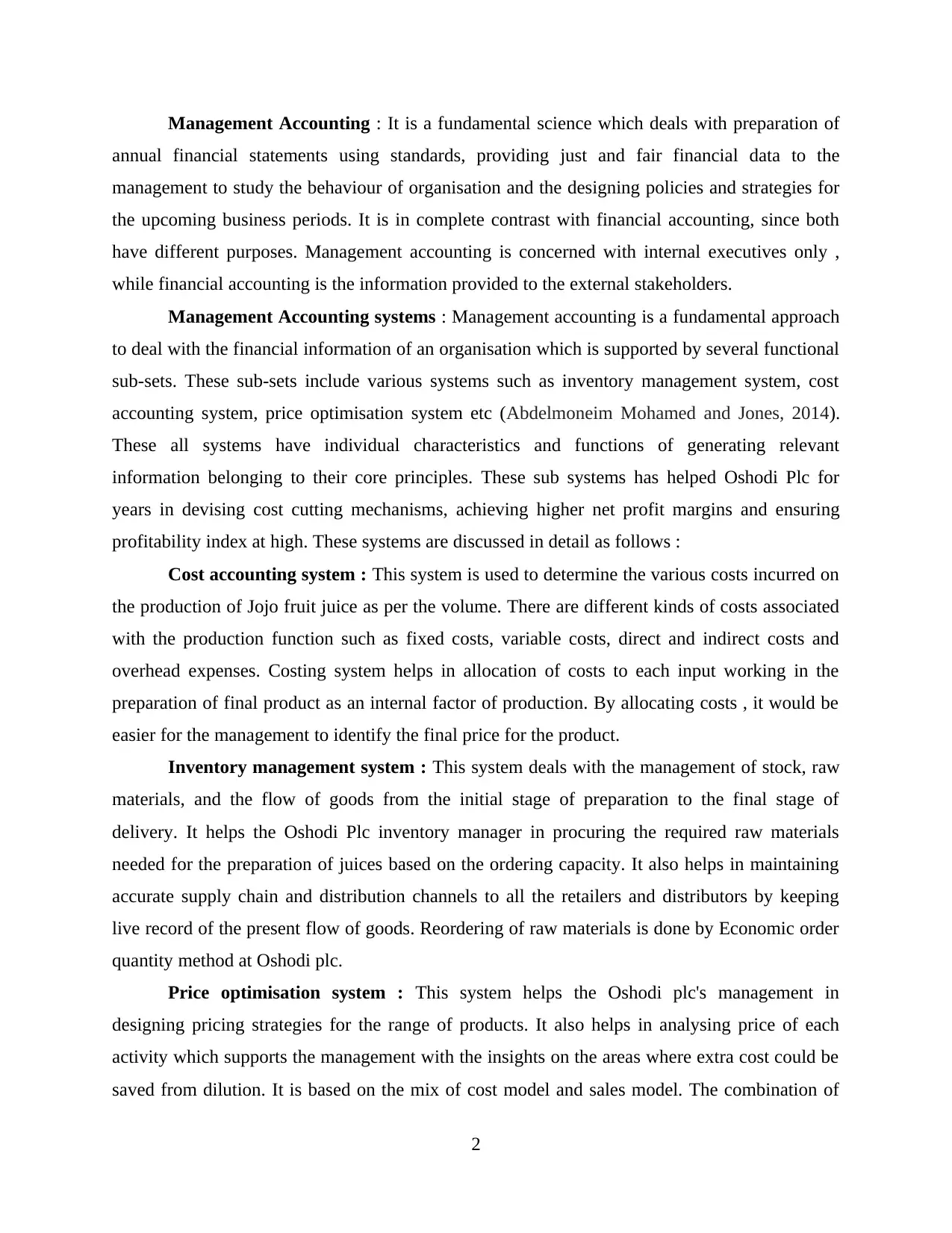
Management Accounting : It is a fundamental science which deals with preparation of
annual financial statements using standards, providing just and fair financial data to the
management to study the behaviour of organisation and the designing policies and strategies for
the upcoming business periods. It is in complete contrast with financial accounting, since both
have different purposes. Management accounting is concerned with internal executives only ,
while financial accounting is the information provided to the external stakeholders.
Management Accounting systems : Management accounting is a fundamental approach
to deal with the financial information of an organisation which is supported by several functional
sub-sets. These sub-sets include various systems such as inventory management system, cost
accounting system, price optimisation system etc (Abdelmoneim Mohamed and Jones, 2014).
These all systems have individual characteristics and functions of generating relevant
information belonging to their core principles. These sub systems has helped Oshodi Plc for
years in devising cost cutting mechanisms, achieving higher net profit margins and ensuring
profitability index at high. These systems are discussed in detail as follows :
Cost accounting system : This system is used to determine the various costs incurred on
the production of Jojo fruit juice as per the volume. There are different kinds of costs associated
with the production function such as fixed costs, variable costs, direct and indirect costs and
overhead expenses. Costing system helps in allocation of costs to each input working in the
preparation of final product as an internal factor of production. By allocating costs , it would be
easier for the management to identify the final price for the product.
Inventory management system : This system deals with the management of stock, raw
materials, and the flow of goods from the initial stage of preparation to the final stage of
delivery. It helps the Oshodi Plc inventory manager in procuring the required raw materials
needed for the preparation of juices based on the ordering capacity. It also helps in maintaining
accurate supply chain and distribution channels to all the retailers and distributors by keeping
live record of the present flow of goods. Reordering of raw materials is done by Economic order
quantity method at Oshodi plc.
Price optimisation system : This system helps the Oshodi plc's management in
designing pricing strategies for the range of products. It also helps in analysing price of each
activity which supports the management with the insights on the areas where extra cost could be
saved from dilution. It is based on the mix of cost model and sales model. The combination of
2
annual financial statements using standards, providing just and fair financial data to the
management to study the behaviour of organisation and the designing policies and strategies for
the upcoming business periods. It is in complete contrast with financial accounting, since both
have different purposes. Management accounting is concerned with internal executives only ,
while financial accounting is the information provided to the external stakeholders.
Management Accounting systems : Management accounting is a fundamental approach
to deal with the financial information of an organisation which is supported by several functional
sub-sets. These sub-sets include various systems such as inventory management system, cost
accounting system, price optimisation system etc (Abdelmoneim Mohamed and Jones, 2014).
These all systems have individual characteristics and functions of generating relevant
information belonging to their core principles. These sub systems has helped Oshodi Plc for
years in devising cost cutting mechanisms, achieving higher net profit margins and ensuring
profitability index at high. These systems are discussed in detail as follows :
Cost accounting system : This system is used to determine the various costs incurred on
the production of Jojo fruit juice as per the volume. There are different kinds of costs associated
with the production function such as fixed costs, variable costs, direct and indirect costs and
overhead expenses. Costing system helps in allocation of costs to each input working in the
preparation of final product as an internal factor of production. By allocating costs , it would be
easier for the management to identify the final price for the product.
Inventory management system : This system deals with the management of stock, raw
materials, and the flow of goods from the initial stage of preparation to the final stage of
delivery. It helps the Oshodi Plc inventory manager in procuring the required raw materials
needed for the preparation of juices based on the ordering capacity. It also helps in maintaining
accurate supply chain and distribution channels to all the retailers and distributors by keeping
live record of the present flow of goods. Reordering of raw materials is done by Economic order
quantity method at Oshodi plc.
Price optimisation system : This system helps the Oshodi plc's management in
designing pricing strategies for the range of products. It also helps in analysing price of each
activity which supports the management with the insights on the areas where extra cost could be
saved from dilution. It is based on the mix of cost model and sales model. The combination of
2
Paraphrase This Document
Need a fresh take? Get an instant paraphrase of this document with our AI Paraphraser
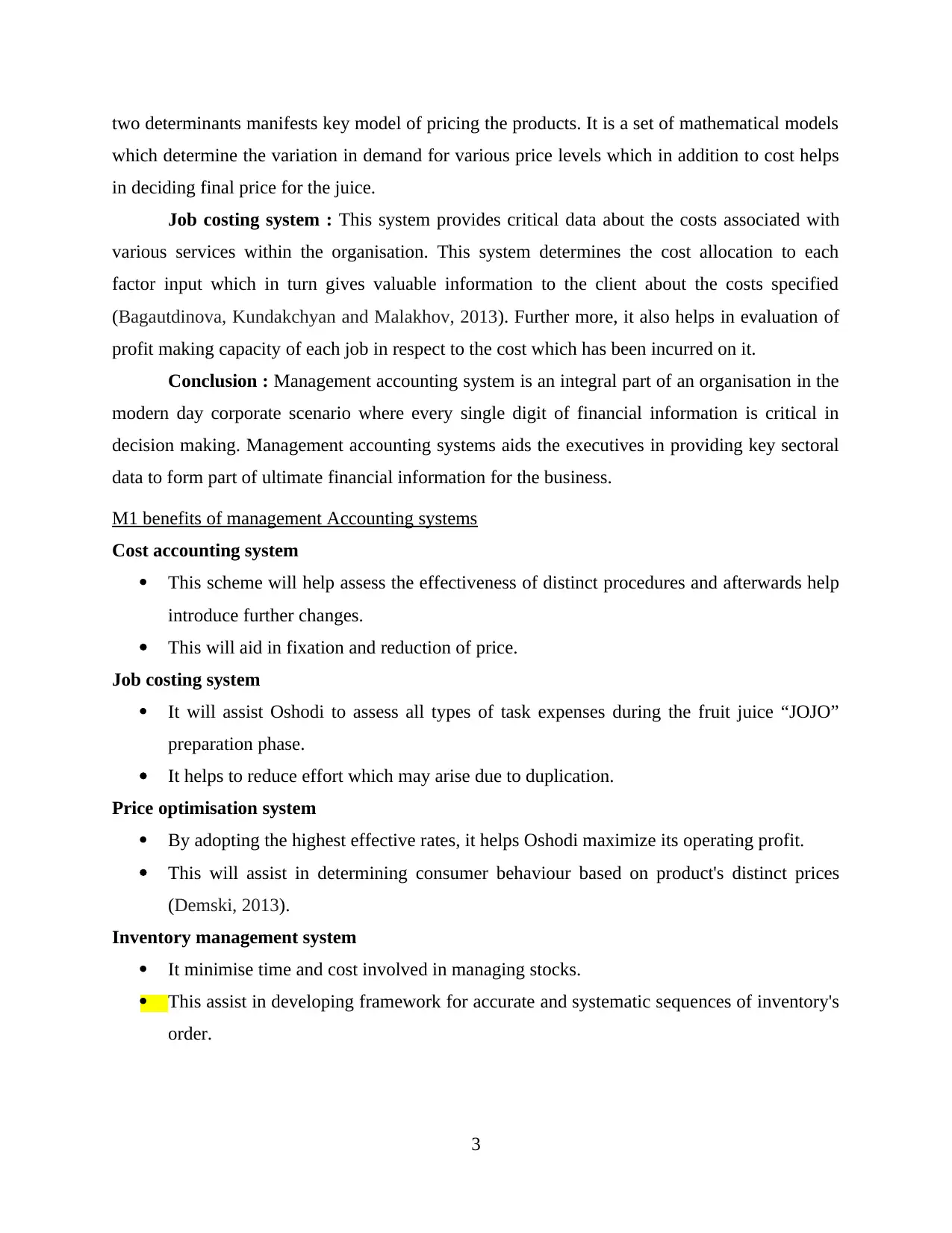
two determinants manifests key model of pricing the products. It is a set of mathematical models
which determine the variation in demand for various price levels which in addition to cost helps
in deciding final price for the juice.
Job costing system : This system provides critical data about the costs associated with
various services within the organisation. This system determines the cost allocation to each
factor input which in turn gives valuable information to the client about the costs specified
(Bagautdinova, Kundakchyan and Malakhov, 2013). Further more, it also helps in evaluation of
profit making capacity of each job in respect to the cost which has been incurred on it.
Conclusion : Management accounting system is an integral part of an organisation in the
modern day corporate scenario where every single digit of financial information is critical in
decision making. Management accounting systems aids the executives in providing key sectoral
data to form part of ultimate financial information for the business.
M1 benefits of management Accounting systems
Cost accounting system
This scheme will help assess the effectiveness of distinct procedures and afterwards help
introduce further changes.
This will aid in fixation and reduction of price.
Job costing system
It will assist Oshodi to assess all types of task expenses during the fruit juice “JOJO”
preparation phase.
It helps to reduce effort which may arise due to duplication.
Price optimisation system
By adopting the highest effective rates, it helps Oshodi maximize its operating profit.
This will assist in determining consumer behaviour based on product's distinct prices
(Demski, 2013).
Inventory management system
It minimise time and cost involved in managing stocks.
This assist in developing framework for accurate and systematic sequences of inventory's
order.
3
which determine the variation in demand for various price levels which in addition to cost helps
in deciding final price for the juice.
Job costing system : This system provides critical data about the costs associated with
various services within the organisation. This system determines the cost allocation to each
factor input which in turn gives valuable information to the client about the costs specified
(Bagautdinova, Kundakchyan and Malakhov, 2013). Further more, it also helps in evaluation of
profit making capacity of each job in respect to the cost which has been incurred on it.
Conclusion : Management accounting system is an integral part of an organisation in the
modern day corporate scenario where every single digit of financial information is critical in
decision making. Management accounting systems aids the executives in providing key sectoral
data to form part of ultimate financial information for the business.
M1 benefits of management Accounting systems
Cost accounting system
This scheme will help assess the effectiveness of distinct procedures and afterwards help
introduce further changes.
This will aid in fixation and reduction of price.
Job costing system
It will assist Oshodi to assess all types of task expenses during the fruit juice “JOJO”
preparation phase.
It helps to reduce effort which may arise due to duplication.
Price optimisation system
By adopting the highest effective rates, it helps Oshodi maximize its operating profit.
This will assist in determining consumer behaviour based on product's distinct prices
(Demski, 2013).
Inventory management system
It minimise time and cost involved in managing stocks.
This assist in developing framework for accurate and systematic sequences of inventory's
order.
3
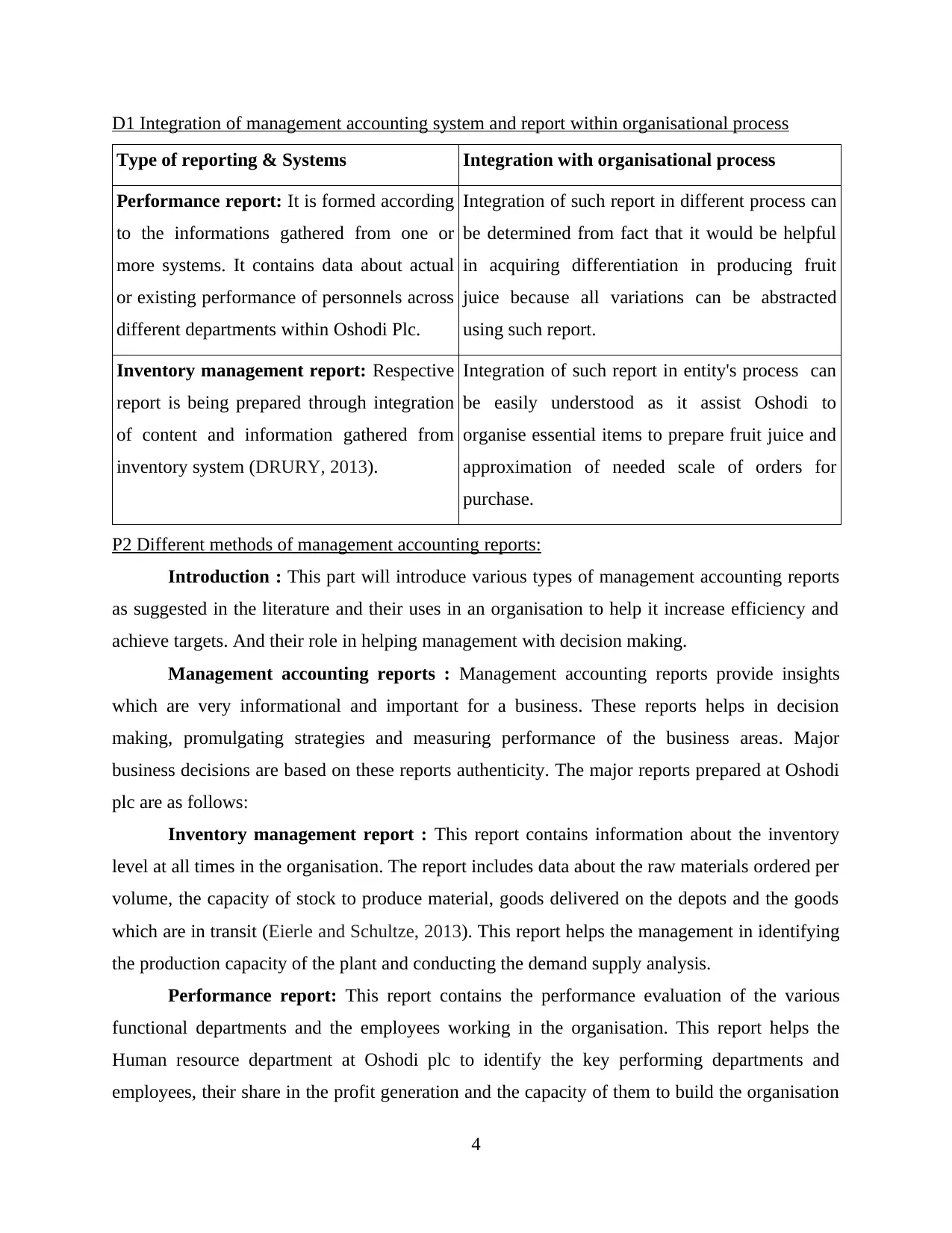
D1 Integration of management accounting system and report within organisational process
Type of reporting & Systems Integration with organisational process
Performance report: It is formed according
to the informations gathered from one or
more systems. It contains data about actual
or existing performance of personnels across
different departments within Oshodi Plc.
Integration of such report in different process can
be determined from fact that it would be helpful
in acquiring differentiation in producing fruit
juice because all variations can be abstracted
using such report.
Inventory management report: Respective
report is being prepared through integration
of content and information gathered from
inventory system (DRURY, 2013).
Integration of such report in entity's process can
be easily understood as it assist Oshodi to
organise essential items to prepare fruit juice and
approximation of needed scale of orders for
purchase.
P2 Different methods of management accounting reports:
Introduction : This part will introduce various types of management accounting reports
as suggested in the literature and their uses in an organisation to help it increase efficiency and
achieve targets. And their role in helping management with decision making.
Management accounting reports : Management accounting reports provide insights
which are very informational and important for a business. These reports helps in decision
making, promulgating strategies and measuring performance of the business areas. Major
business decisions are based on these reports authenticity. The major reports prepared at Oshodi
plc are as follows:
Inventory management report : This report contains information about the inventory
level at all times in the organisation. The report includes data about the raw materials ordered per
volume, the capacity of stock to produce material, goods delivered on the depots and the goods
which are in transit (Eierle and Schultze, 2013). This report helps the management in identifying
the production capacity of the plant and conducting the demand supply analysis.
Performance report: This report contains the performance evaluation of the various
functional departments and the employees working in the organisation. This report helps the
Human resource department at Oshodi plc to identify the key performing departments and
employees, their share in the profit generation and the capacity of them to build the organisation
4
Type of reporting & Systems Integration with organisational process
Performance report: It is formed according
to the informations gathered from one or
more systems. It contains data about actual
or existing performance of personnels across
different departments within Oshodi Plc.
Integration of such report in different process can
be determined from fact that it would be helpful
in acquiring differentiation in producing fruit
juice because all variations can be abstracted
using such report.
Inventory management report: Respective
report is being prepared through integration
of content and information gathered from
inventory system (DRURY, 2013).
Integration of such report in entity's process can
be easily understood as it assist Oshodi to
organise essential items to prepare fruit juice and
approximation of needed scale of orders for
purchase.
P2 Different methods of management accounting reports:
Introduction : This part will introduce various types of management accounting reports
as suggested in the literature and their uses in an organisation to help it increase efficiency and
achieve targets. And their role in helping management with decision making.
Management accounting reports : Management accounting reports provide insights
which are very informational and important for a business. These reports helps in decision
making, promulgating strategies and measuring performance of the business areas. Major
business decisions are based on these reports authenticity. The major reports prepared at Oshodi
plc are as follows:
Inventory management report : This report contains information about the inventory
level at all times in the organisation. The report includes data about the raw materials ordered per
volume, the capacity of stock to produce material, goods delivered on the depots and the goods
which are in transit (Eierle and Schultze, 2013). This report helps the management in identifying
the production capacity of the plant and conducting the demand supply analysis.
Performance report: This report contains the performance evaluation of the various
functional departments and the employees working in the organisation. This report helps the
Human resource department at Oshodi plc to identify the key performing departments and
employees, their share in the profit generation and the capacity of them to build the organisation
4
⊘ This is a preview!⊘
Do you want full access?
Subscribe today to unlock all pages.

Trusted by 1+ million students worldwide
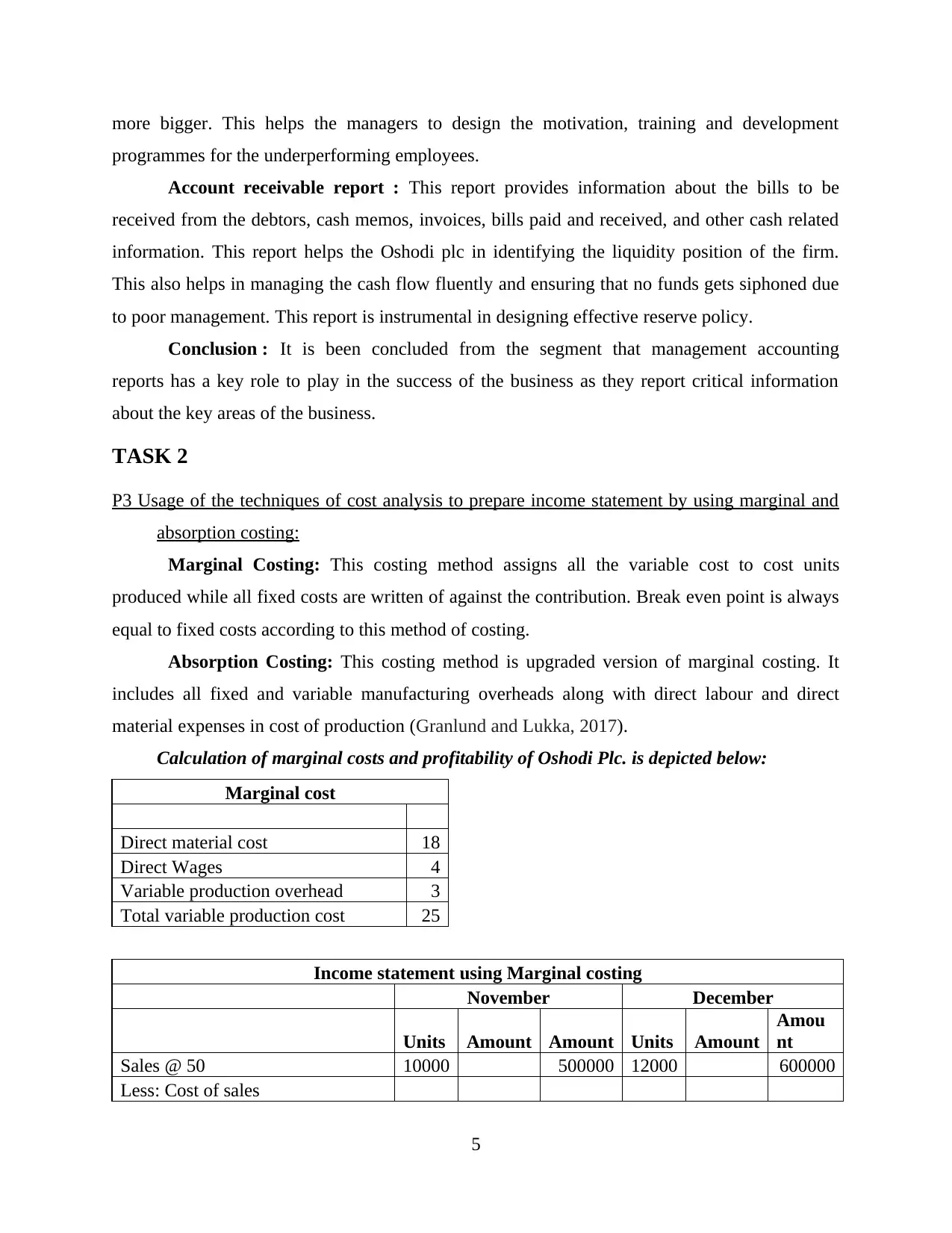
more bigger. This helps the managers to design the motivation, training and development
programmes for the underperforming employees.
Account receivable report : This report provides information about the bills to be
received from the debtors, cash memos, invoices, bills paid and received, and other cash related
information. This report helps the Oshodi plc in identifying the liquidity position of the firm.
This also helps in managing the cash flow fluently and ensuring that no funds gets siphoned due
to poor management. This report is instrumental in designing effective reserve policy.
Conclusion : It is been concluded from the segment that management accounting
reports has a key role to play in the success of the business as they report critical information
about the key areas of the business.
TASK 2
P3 Usage of the techniques of cost analysis to prepare income statement by using marginal and
absorption costing:
Marginal Costing: This costing method assigns all the variable cost to cost units
produced while all fixed costs are written of against the contribution. Break even point is always
equal to fixed costs according to this method of costing.
Absorption Costing: This costing method is upgraded version of marginal costing. It
includes all fixed and variable manufacturing overheads along with direct labour and direct
material expenses in cost of production (Granlund and Lukka, 2017).
Calculation of marginal costs and profitability of Oshodi Plc. is depicted below:
Marginal cost
Direct material cost 18
Direct Wages 4
Variable production overhead 3
Total variable production cost 25
Income statement using Marginal costing
November December
Units Amount Amount Units Amount
Amou
nt
Sales @ 50 10000 500000 12000 600000
Less: Cost of sales
5
programmes for the underperforming employees.
Account receivable report : This report provides information about the bills to be
received from the debtors, cash memos, invoices, bills paid and received, and other cash related
information. This report helps the Oshodi plc in identifying the liquidity position of the firm.
This also helps in managing the cash flow fluently and ensuring that no funds gets siphoned due
to poor management. This report is instrumental in designing effective reserve policy.
Conclusion : It is been concluded from the segment that management accounting
reports has a key role to play in the success of the business as they report critical information
about the key areas of the business.
TASK 2
P3 Usage of the techniques of cost analysis to prepare income statement by using marginal and
absorption costing:
Marginal Costing: This costing method assigns all the variable cost to cost units
produced while all fixed costs are written of against the contribution. Break even point is always
equal to fixed costs according to this method of costing.
Absorption Costing: This costing method is upgraded version of marginal costing. It
includes all fixed and variable manufacturing overheads along with direct labour and direct
material expenses in cost of production (Granlund and Lukka, 2017).
Calculation of marginal costs and profitability of Oshodi Plc. is depicted below:
Marginal cost
Direct material cost 18
Direct Wages 4
Variable production overhead 3
Total variable production cost 25
Income statement using Marginal costing
November December
Units Amount Amount Units Amount
Amou
nt
Sales @ 50 10000 500000 12000 600000
Less: Cost of sales
5
Paraphrase This Document
Need a fresh take? Get an instant paraphrase of this document with our AI Paraphraser
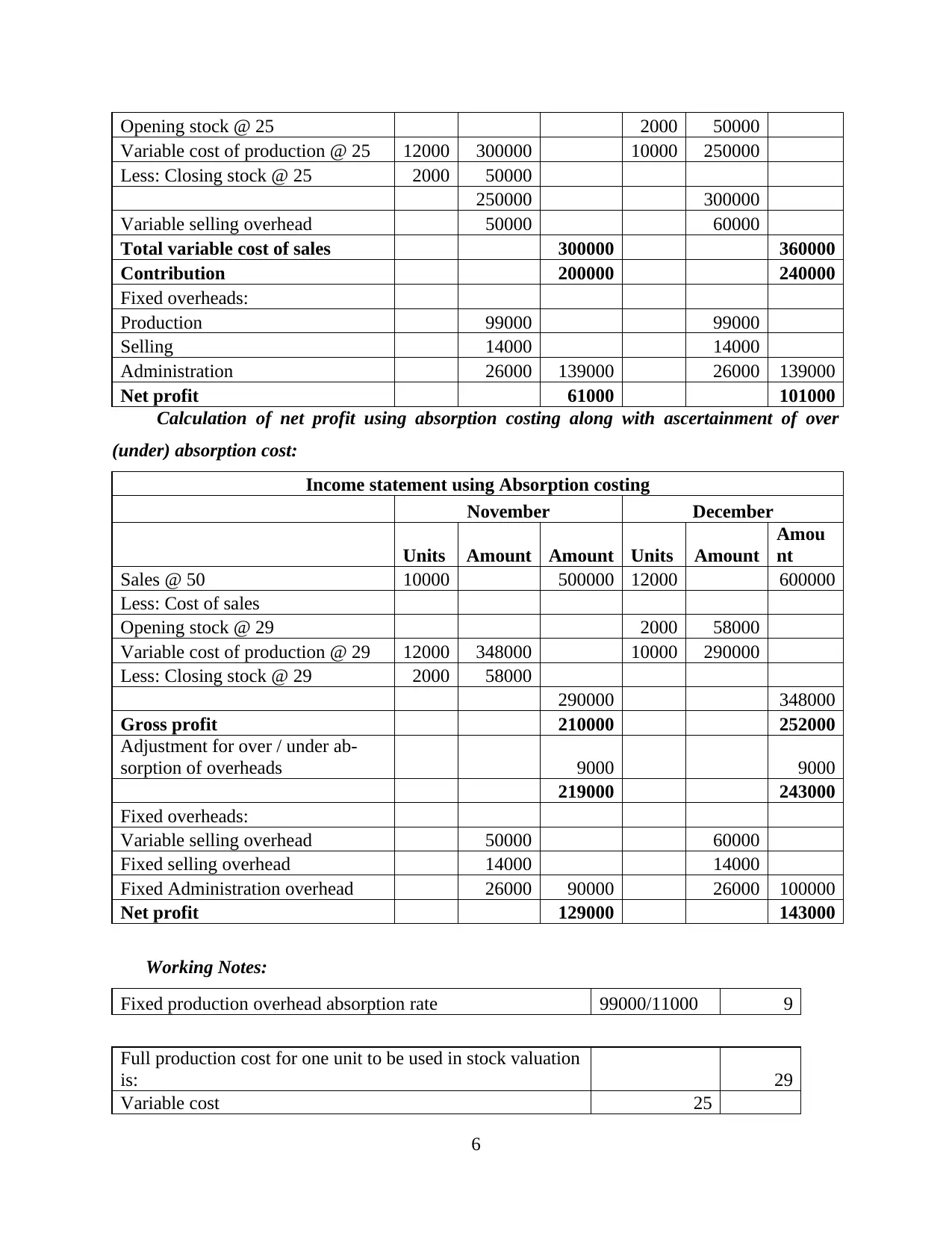
Opening stock @ 25 2000 50000
Variable cost of production @ 25 12000 300000 10000 250000
Less: Closing stock @ 25 2000 50000
250000 300000
Variable selling overhead 50000 60000
Total variable cost of sales 300000 360000
Contribution 200000 240000
Fixed overheads:
Production 99000 99000
Selling 14000 14000
Administration 26000 139000 26000 139000
Net profit 61000 101000
Calculation of net profit using absorption costing along with ascertainment of over
(under) absorption cost:
Income statement using Absorption costing
November December
Units Amount Amount Units Amount
Amou
nt
Sales @ 50 10000 500000 12000 600000
Less: Cost of sales
Opening stock @ 29 2000 58000
Variable cost of production @ 29 12000 348000 10000 290000
Less: Closing stock @ 29 2000 58000
290000 348000
Gross profit 210000 252000
Adjustment for over / under ab-
sorption of overheads 9000 9000
219000 243000
Fixed overheads:
Variable selling overhead 50000 60000
Fixed selling overhead 14000 14000
Fixed Administration overhead 26000 90000 26000 100000
Net profit 129000 143000
Working Notes:
Fixed production overhead absorption rate 99000/11000 9
Full production cost for one unit to be used in stock valuation
is: 29
Variable cost 25
6
Variable cost of production @ 25 12000 300000 10000 250000
Less: Closing stock @ 25 2000 50000
250000 300000
Variable selling overhead 50000 60000
Total variable cost of sales 300000 360000
Contribution 200000 240000
Fixed overheads:
Production 99000 99000
Selling 14000 14000
Administration 26000 139000 26000 139000
Net profit 61000 101000
Calculation of net profit using absorption costing along with ascertainment of over
(under) absorption cost:
Income statement using Absorption costing
November December
Units Amount Amount Units Amount
Amou
nt
Sales @ 50 10000 500000 12000 600000
Less: Cost of sales
Opening stock @ 29 2000 58000
Variable cost of production @ 29 12000 348000 10000 290000
Less: Closing stock @ 29 2000 58000
290000 348000
Gross profit 210000 252000
Adjustment for over / under ab-
sorption of overheads 9000 9000
219000 243000
Fixed overheads:
Variable selling overhead 50000 60000
Fixed selling overhead 14000 14000
Fixed Administration overhead 26000 90000 26000 100000
Net profit 129000 143000
Working Notes:
Fixed production overhead absorption rate 99000/11000 9
Full production cost for one unit to be used in stock valuation
is: 29
Variable cost 25
6
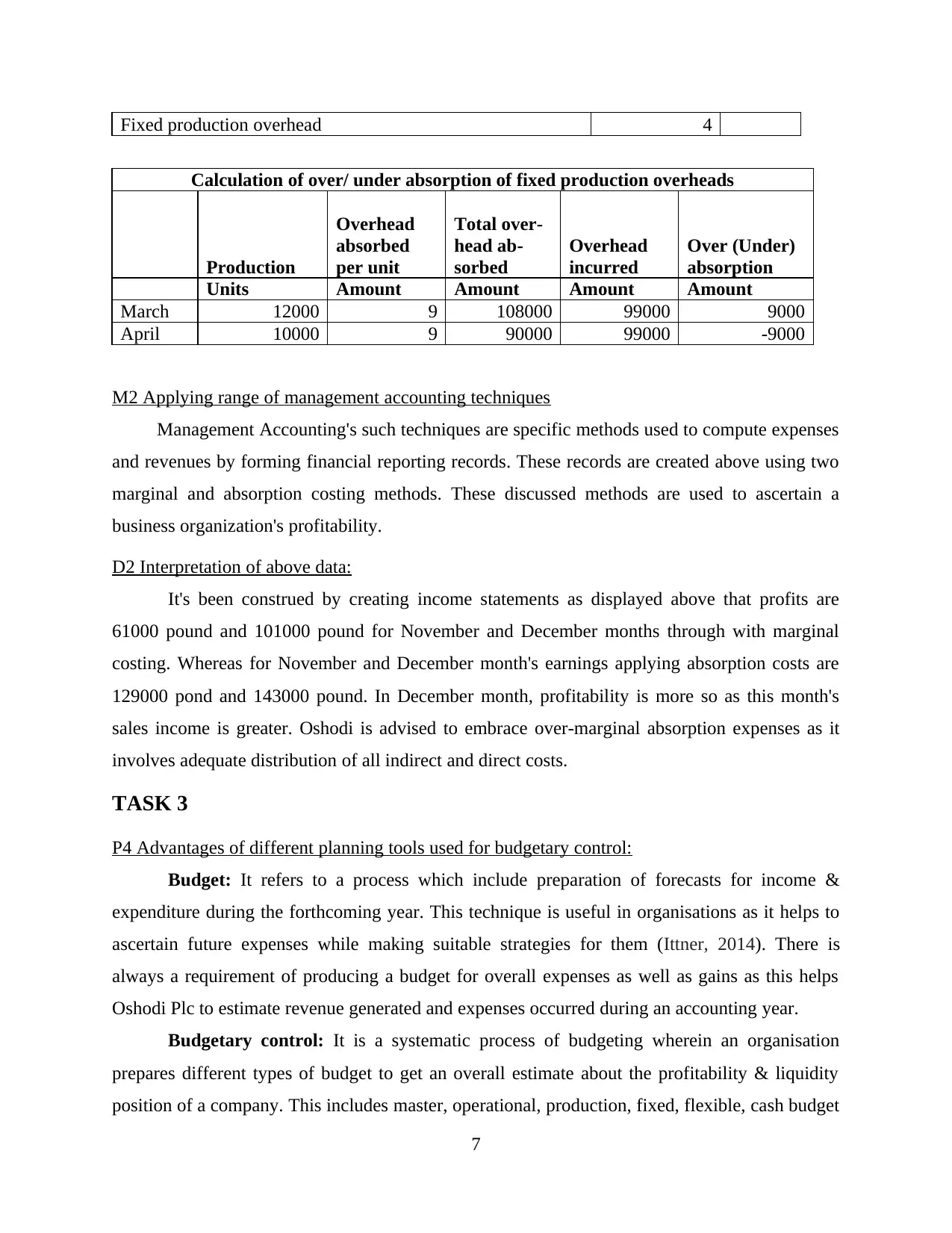
Fixed production overhead 4
Calculation of over/ under absorption of fixed production overheads
Production
Overhead
absorbed
per unit
Total over-
head ab-
sorbed
Overhead
incurred
Over (Under)
absorption
Units Amount Amount Amount Amount
March 12000 9 108000 99000 9000
April 10000 9 90000 99000 -9000
M2 Applying range of management accounting techniques
Management Accounting's such techniques are specific methods used to compute expenses
and revenues by forming financial reporting records. These records are created above using two
marginal and absorption costing methods. These discussed methods are used to ascertain a
business organization's profitability.
D2 Interpretation of above data:
It's been construed by creating income statements as displayed above that profits are
61000 pound and 101000 pound for November and December months through with marginal
costing. Whereas for November and December month's earnings applying absorption costs are
129000 pond and 143000 pound. In December month, profitability is more so as this month's
sales income is greater. Oshodi is advised to embrace over-marginal absorption expenses as it
involves adequate distribution of all indirect and direct costs.
TASK 3
P4 Advantages of different planning tools used for budgetary control:
Budget: It refers to a process which include preparation of forecasts for income &
expenditure during the forthcoming year. This technique is useful in organisations as it helps to
ascertain future expenses while making suitable strategies for them (Ittner, 2014). There is
always a requirement of producing a budget for overall expenses as well as gains as this helps
Oshodi Plc to estimate revenue generated and expenses occurred during an accounting year.
Budgetary control: It is a systematic process of budgeting wherein an organisation
prepares different types of budget to get an overall estimate about the profitability & liquidity
position of a company. This includes master, operational, production, fixed, flexible, cash budget
7
Calculation of over/ under absorption of fixed production overheads
Production
Overhead
absorbed
per unit
Total over-
head ab-
sorbed
Overhead
incurred
Over (Under)
absorption
Units Amount Amount Amount Amount
March 12000 9 108000 99000 9000
April 10000 9 90000 99000 -9000
M2 Applying range of management accounting techniques
Management Accounting's such techniques are specific methods used to compute expenses
and revenues by forming financial reporting records. These records are created above using two
marginal and absorption costing methods. These discussed methods are used to ascertain a
business organization's profitability.
D2 Interpretation of above data:
It's been construed by creating income statements as displayed above that profits are
61000 pound and 101000 pound for November and December months through with marginal
costing. Whereas for November and December month's earnings applying absorption costs are
129000 pond and 143000 pound. In December month, profitability is more so as this month's
sales income is greater. Oshodi is advised to embrace over-marginal absorption expenses as it
involves adequate distribution of all indirect and direct costs.
TASK 3
P4 Advantages of different planning tools used for budgetary control:
Budget: It refers to a process which include preparation of forecasts for income &
expenditure during the forthcoming year. This technique is useful in organisations as it helps to
ascertain future expenses while making suitable strategies for them (Ittner, 2014). There is
always a requirement of producing a budget for overall expenses as well as gains as this helps
Oshodi Plc to estimate revenue generated and expenses occurred during an accounting year.
Budgetary control: It is a systematic process of budgeting wherein an organisation
prepares different types of budget to get an overall estimate about the profitability & liquidity
position of a company. This includes master, operational, production, fixed, flexible, cash budget
7
⊘ This is a preview!⊘
Do you want full access?
Subscribe today to unlock all pages.

Trusted by 1+ million students worldwide
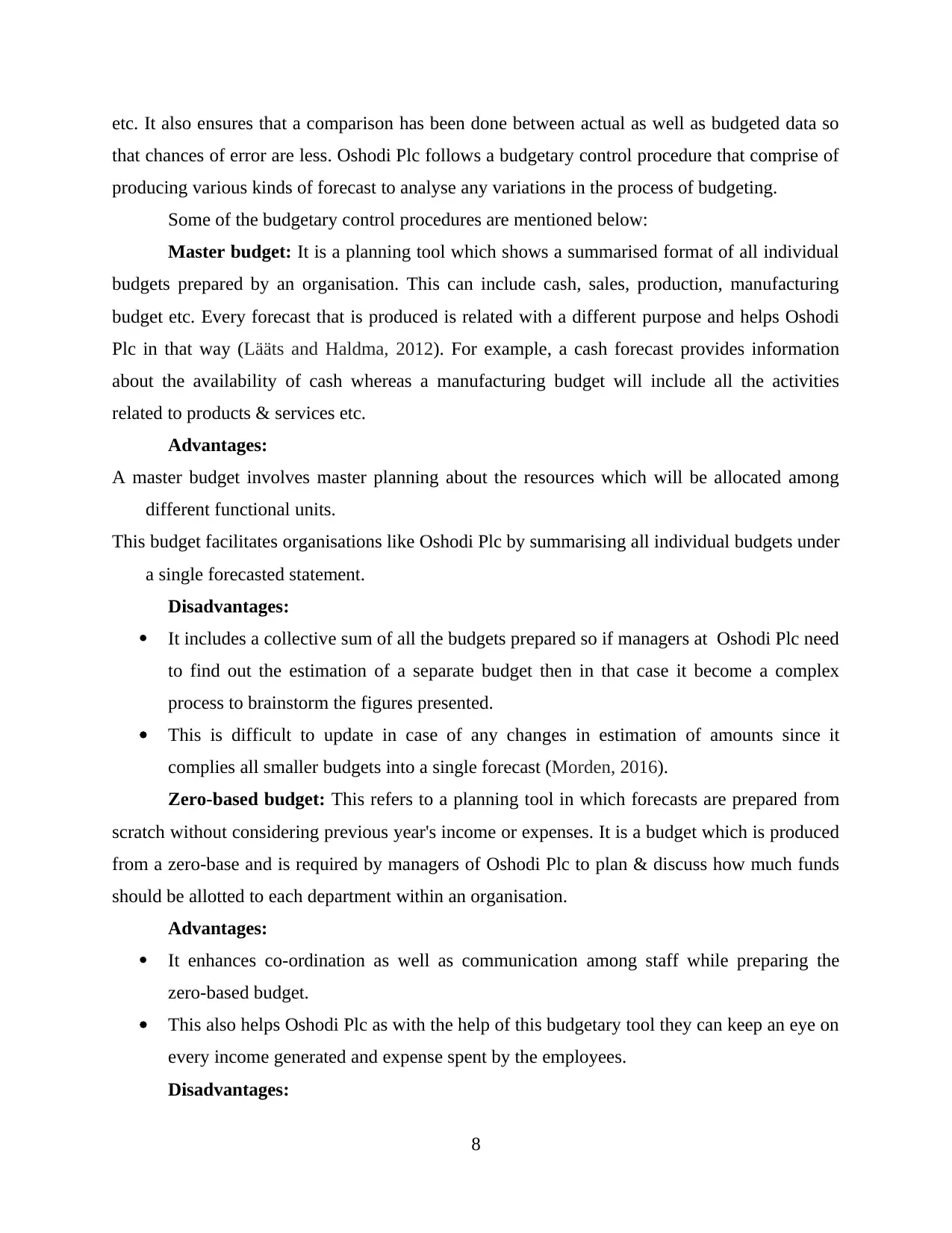
etc. It also ensures that a comparison has been done between actual as well as budgeted data so
that chances of error are less. Oshodi Plc follows a budgetary control procedure that comprise of
producing various kinds of forecast to analyse any variations in the process of budgeting.
Some of the budgetary control procedures are mentioned below:
Master budget: It is a planning tool which shows a summarised format of all individual
budgets prepared by an organisation. This can include cash, sales, production, manufacturing
budget etc. Every forecast that is produced is related with a different purpose and helps Oshodi
Plc in that way (Lääts and Haldma, 2012). For example, a cash forecast provides information
about the availability of cash whereas a manufacturing budget will include all the activities
related to products & services etc.
Advantages:
A master budget involves master planning about the resources which will be allocated among
different functional units.
This budget facilitates organisations like Oshodi Plc by summarising all individual budgets under
a single forecasted statement.
Disadvantages:
It includes a collective sum of all the budgets prepared so if managers at Oshodi Plc need
to find out the estimation of a separate budget then in that case it become a complex
process to brainstorm the figures presented.
This is difficult to update in case of any changes in estimation of amounts since it
complies all smaller budgets into a single forecast (Morden, 2016).
Zero-based budget: This refers to a planning tool in which forecasts are prepared from
scratch without considering previous year's income or expenses. It is a budget which is produced
from a zero-base and is required by managers of Oshodi Plc to plan & discuss how much funds
should be allotted to each department within an organisation.
Advantages:
It enhances co-ordination as well as communication among staff while preparing the
zero-based budget.
This also helps Oshodi Plc as with the help of this budgetary tool they can keep an eye on
every income generated and expense spent by the employees.
Disadvantages:
8
that chances of error are less. Oshodi Plc follows a budgetary control procedure that comprise of
producing various kinds of forecast to analyse any variations in the process of budgeting.
Some of the budgetary control procedures are mentioned below:
Master budget: It is a planning tool which shows a summarised format of all individual
budgets prepared by an organisation. This can include cash, sales, production, manufacturing
budget etc. Every forecast that is produced is related with a different purpose and helps Oshodi
Plc in that way (Lääts and Haldma, 2012). For example, a cash forecast provides information
about the availability of cash whereas a manufacturing budget will include all the activities
related to products & services etc.
Advantages:
A master budget involves master planning about the resources which will be allocated among
different functional units.
This budget facilitates organisations like Oshodi Plc by summarising all individual budgets under
a single forecasted statement.
Disadvantages:
It includes a collective sum of all the budgets prepared so if managers at Oshodi Plc need
to find out the estimation of a separate budget then in that case it become a complex
process to brainstorm the figures presented.
This is difficult to update in case of any changes in estimation of amounts since it
complies all smaller budgets into a single forecast (Morden, 2016).
Zero-based budget: This refers to a planning tool in which forecasts are prepared from
scratch without considering previous year's income or expenses. It is a budget which is produced
from a zero-base and is required by managers of Oshodi Plc to plan & discuss how much funds
should be allotted to each department within an organisation.
Advantages:
It enhances co-ordination as well as communication among staff while preparing the
zero-based budget.
This also helps Oshodi Plc as with the help of this budgetary tool they can keep an eye on
every income generated and expense spent by the employees.
Disadvantages:
8
Paraphrase This Document
Need a fresh take? Get an instant paraphrase of this document with our AI Paraphraser
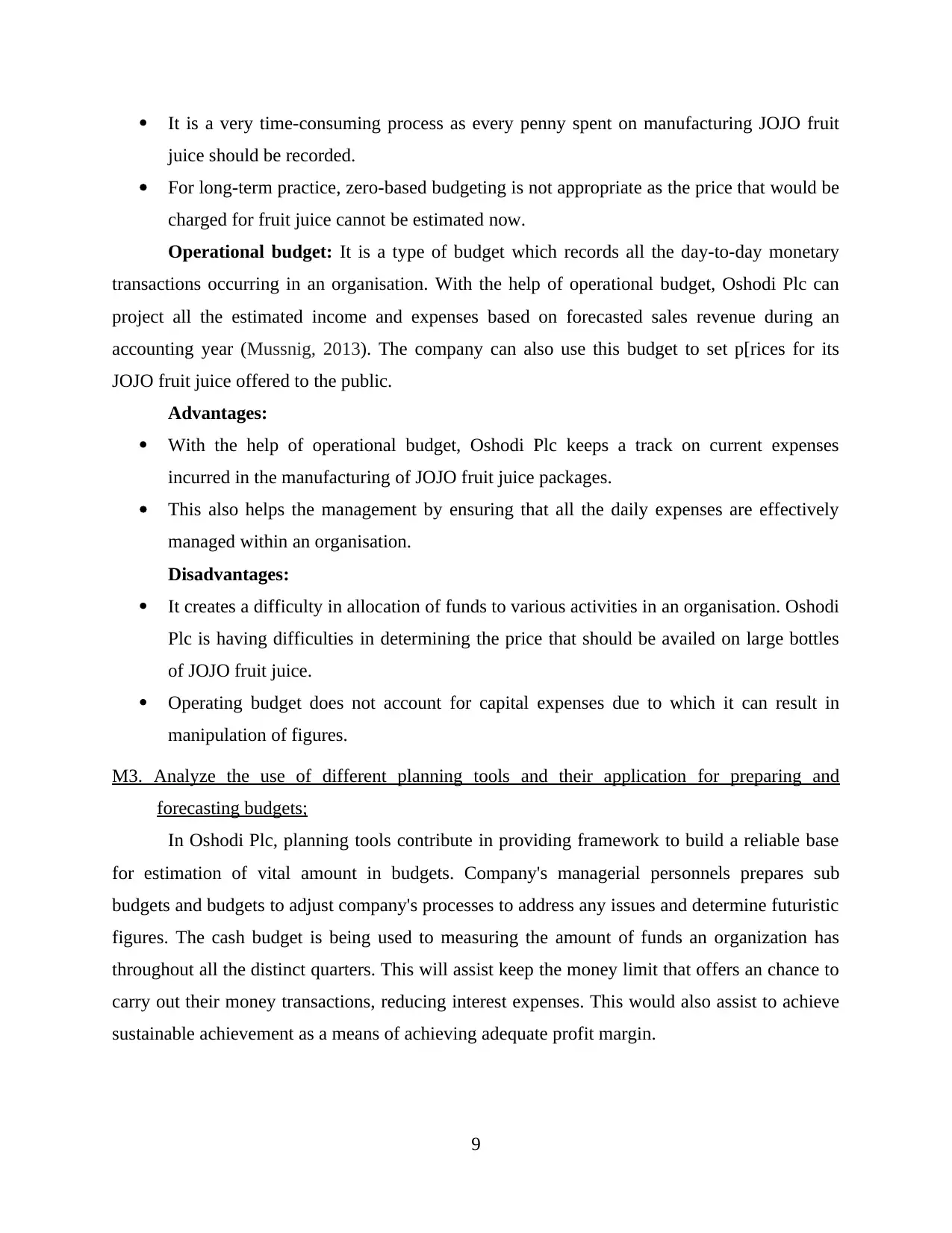
It is a very time-consuming process as every penny spent on manufacturing JOJO fruit
juice should be recorded.
For long-term practice, zero-based budgeting is not appropriate as the price that would be
charged for fruit juice cannot be estimated now.
Operational budget: It is a type of budget which records all the day-to-day monetary
transactions occurring in an organisation. With the help of operational budget, Oshodi Plc can
project all the estimated income and expenses based on forecasted sales revenue during an
accounting year (Mussnig, 2013). The company can also use this budget to set p[rices for its
JOJO fruit juice offered to the public.
Advantages:
With the help of operational budget, Oshodi Plc keeps a track on current expenses
incurred in the manufacturing of JOJO fruit juice packages.
This also helps the management by ensuring that all the daily expenses are effectively
managed within an organisation.
Disadvantages:
It creates a difficulty in allocation of funds to various activities in an organisation. Oshodi
Plc is having difficulties in determining the price that should be availed on large bottles
of JOJO fruit juice.
Operating budget does not account for capital expenses due to which it can result in
manipulation of figures.
M3. Analyze the use of different planning tools and their application for preparing and
forecasting budgets;
In Oshodi Plc, planning tools contribute in providing framework to build a reliable base
for estimation of vital amount in budgets. Company's managerial personnels prepares sub
budgets and budgets to adjust company's processes to address any issues and determine futuristic
figures. The cash budget is being used to measuring the amount of funds an organization has
throughout all the distinct quarters. This will assist keep the money limit that offers an chance to
carry out their money transactions, reducing interest expenses. This would also assist to achieve
sustainable achievement as a means of achieving adequate profit margin.
9
juice should be recorded.
For long-term practice, zero-based budgeting is not appropriate as the price that would be
charged for fruit juice cannot be estimated now.
Operational budget: It is a type of budget which records all the day-to-day monetary
transactions occurring in an organisation. With the help of operational budget, Oshodi Plc can
project all the estimated income and expenses based on forecasted sales revenue during an
accounting year (Mussnig, 2013). The company can also use this budget to set p[rices for its
JOJO fruit juice offered to the public.
Advantages:
With the help of operational budget, Oshodi Plc keeps a track on current expenses
incurred in the manufacturing of JOJO fruit juice packages.
This also helps the management by ensuring that all the daily expenses are effectively
managed within an organisation.
Disadvantages:
It creates a difficulty in allocation of funds to various activities in an organisation. Oshodi
Plc is having difficulties in determining the price that should be availed on large bottles
of JOJO fruit juice.
Operating budget does not account for capital expenses due to which it can result in
manipulation of figures.
M3. Analyze the use of different planning tools and their application for preparing and
forecasting budgets;
In Oshodi Plc, planning tools contribute in providing framework to build a reliable base
for estimation of vital amount in budgets. Company's managerial personnels prepares sub
budgets and budgets to adjust company's processes to address any issues and determine futuristic
figures. The cash budget is being used to measuring the amount of funds an organization has
throughout all the distinct quarters. This will assist keep the money limit that offers an chance to
carry out their money transactions, reducing interest expenses. This would also assist to achieve
sustainable achievement as a means of achieving adequate profit margin.
9
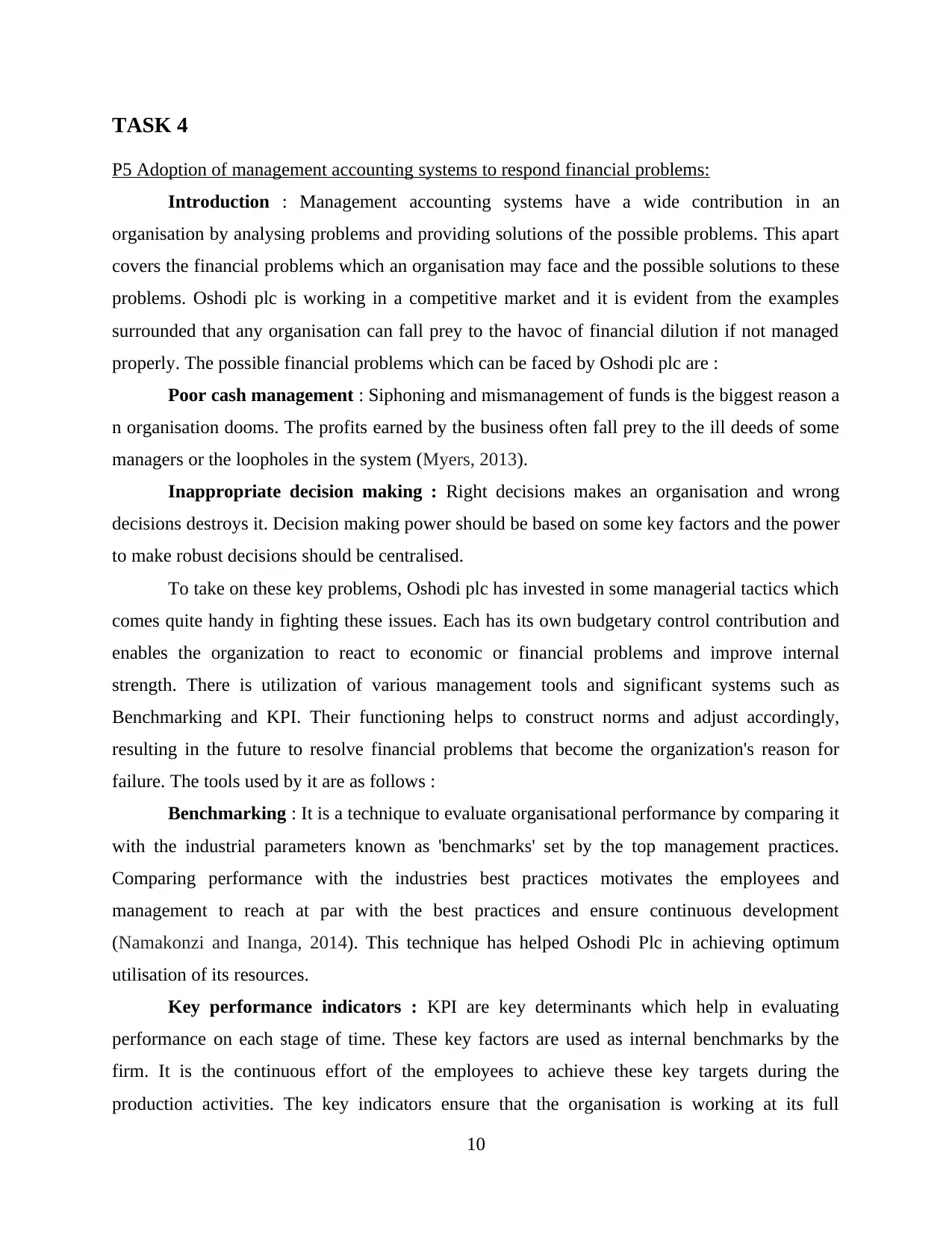
TASK 4
P5 Adoption of management accounting systems to respond financial problems:
Introduction : Management accounting systems have a wide contribution in an
organisation by analysing problems and providing solutions of the possible problems. This apart
covers the financial problems which an organisation may face and the possible solutions to these
problems. Oshodi plc is working in a competitive market and it is evident from the examples
surrounded that any organisation can fall prey to the havoc of financial dilution if not managed
properly. The possible financial problems which can be faced by Oshodi plc are :
Poor cash management : Siphoning and mismanagement of funds is the biggest reason a
n organisation dooms. The profits earned by the business often fall prey to the ill deeds of some
managers or the loopholes in the system (Myers, 2013).
Inappropriate decision making : Right decisions makes an organisation and wrong
decisions destroys it. Decision making power should be based on some key factors and the power
to make robust decisions should be centralised.
To take on these key problems, Oshodi plc has invested in some managerial tactics which
comes quite handy in fighting these issues. Each has its own budgetary control contribution and
enables the organization to react to economic or financial problems and improve internal
strength. There is utilization of various management tools and significant systems such as
Benchmarking and KPI. Their functioning helps to construct norms and adjust accordingly,
resulting in the future to resolve financial problems that become the organization's reason for
failure. The tools used by it are as follows :
Benchmarking : It is a technique to evaluate organisational performance by comparing it
with the industrial parameters known as 'benchmarks' set by the top management practices.
Comparing performance with the industries best practices motivates the employees and
management to reach at par with the best practices and ensure continuous development
(Namakonzi and Inanga, 2014). This technique has helped Oshodi Plc in achieving optimum
utilisation of its resources.
Key performance indicators : KPI are key determinants which help in evaluating
performance on each stage of time. These key factors are used as internal benchmarks by the
firm. It is the continuous effort of the employees to achieve these key targets during the
production activities. The key indicators ensure that the organisation is working at its full
10
P5 Adoption of management accounting systems to respond financial problems:
Introduction : Management accounting systems have a wide contribution in an
organisation by analysing problems and providing solutions of the possible problems. This apart
covers the financial problems which an organisation may face and the possible solutions to these
problems. Oshodi plc is working in a competitive market and it is evident from the examples
surrounded that any organisation can fall prey to the havoc of financial dilution if not managed
properly. The possible financial problems which can be faced by Oshodi plc are :
Poor cash management : Siphoning and mismanagement of funds is the biggest reason a
n organisation dooms. The profits earned by the business often fall prey to the ill deeds of some
managers or the loopholes in the system (Myers, 2013).
Inappropriate decision making : Right decisions makes an organisation and wrong
decisions destroys it. Decision making power should be based on some key factors and the power
to make robust decisions should be centralised.
To take on these key problems, Oshodi plc has invested in some managerial tactics which
comes quite handy in fighting these issues. Each has its own budgetary control contribution and
enables the organization to react to economic or financial problems and improve internal
strength. There is utilization of various management tools and significant systems such as
Benchmarking and KPI. Their functioning helps to construct norms and adjust accordingly,
resulting in the future to resolve financial problems that become the organization's reason for
failure. The tools used by it are as follows :
Benchmarking : It is a technique to evaluate organisational performance by comparing it
with the industrial parameters known as 'benchmarks' set by the top management practices.
Comparing performance with the industries best practices motivates the employees and
management to reach at par with the best practices and ensure continuous development
(Namakonzi and Inanga, 2014). This technique has helped Oshodi Plc in achieving optimum
utilisation of its resources.
Key performance indicators : KPI are key determinants which help in evaluating
performance on each stage of time. These key factors are used as internal benchmarks by the
firm. It is the continuous effort of the employees to achieve these key targets during the
production activities. The key indicators ensure that the organisation is working at its full
10
⊘ This is a preview!⊘
Do you want full access?
Subscribe today to unlock all pages.

Trusted by 1+ million students worldwide
1 out of 15
Related Documents
Your All-in-One AI-Powered Toolkit for Academic Success.
+13062052269
info@desklib.com
Available 24*7 on WhatsApp / Email
![[object Object]](/_next/static/media/star-bottom.7253800d.svg)
Unlock your academic potential
Copyright © 2020–2025 A2Z Services. All Rights Reserved. Developed and managed by ZUCOL.





